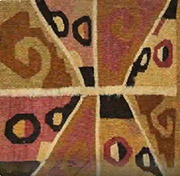Center, Textile Research

IX Jornadas Internacionales de Textiles Precolombinos y Amerindianos / 9th International Conference on PreColumbian and Amerindian Textiles, Museo delle Culture, Milan, 2022
Date of this Version
2024
Document Type
Article
Citation
Published in IX Jornadas Internacionales de Textiles Precolombinos y Amerindianos / 9th International Conference on Pre-Columbian and Amerindian Textiles, Museo delle Culture, Milan, 2022. (Lincoln, Nebraska: Zea Books, 2024)
DOI: 10.32873/unl.dc.zea.1625
Abstract
Las hondas o warakas halladas en la Península de Paracas, contextos mortuorios que datan del final del Formativo Tardío a inicios del Periodo Intermedio Temprano, 400 a.C. – 250 d.C., ofrecen datos inéditos para entender mejor su confección, uso y función simbólica. A partir del estudio de los registros gráficos y fotográficos de las excavaciones de la tumba T.27 en Arena Blanca, realizadas por Engel y Bischof en 1959, hemos desarrollado un nuevo estudio de sus materiales, tanto para la recuperación de los datos como para su puesta en valor, teniendo en cuenta las problemáticas arqueológicas actuales. Hemos comparado los resultados con la información y los objetos recuperados en otros sectores de Cerro Colorado y Wari Kayan excavados por Tello y sus colaboradores entre los años 1925 y 1930, para considerar la importancia sociocultural de las hondas Paracas y Nasca. La ubicación, el número, las técnicas y características decorativas de estos artefactos, dispuestos como ofrendas durante la preparación del fardo funerario, entre las capas de envoltorio o encima o al lado del cuerpo del individuo, nos brindan un nuevo enfoque para reflexionar sobre las prácticas funerarias, los rituales mortuorios y las identidades Paracas y Nasca en esta región hace más de 2000 años.
Slings or warakas from the Paracas Peninsula on the south coast of Peru, found in mortuary contexts spanning from the end of the Late Formative period to the beginning of the Early Intermediate Period, 400 B.C.E – 250 C.E., provide hitherto unpublished data for better understanding their production, use and symbolic function. Based on study of graphic and photographic documentation of the excavation of Arena Blanca tomb T.27, carried out by Engel and Bischof in 1959, this new study of its materials is designed to recover the data and relate it to current archaeological topics. We compare the results with contextual data and analysis of objects recovered in the Cerro Colorado and Wari Kayan sectors, excavated by Tello and his collaborators between 1925 and 1930, to explore the sociocultural importance of Paracas and Nasca slings. The location, number, techniques, and decorative features of these artefacts arranged as offerings during the formation of a funerary bundle, either among the layers of wrapping cloths or on or near the individual’s body, offer a new viewpoint to reflect on funerary practices, mortuary rituals, and Paracas and Nasca identities in this region more than 2000 years ago.
Included in
American Material Culture Commons, Art and Materials Conservation Commons, Fiber, Textile, and Weaving Arts Commons, Indigenous Studies Commons, Latin American History Commons, Museum Studies Commons, Native American Studies Commons, Other History of Art, Architecture, and Archaeology Commons, Other Religion Commons


Comments
Copyright © 2024 Jessica Lévy Contreras & Ann H. Peters.